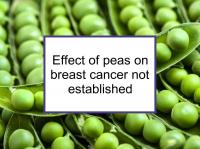Peas (Pisum sativum, also known as sweet peas or green peas) are a good dietary source of beta-carotene, vitamin C, vitamin K, and folate, as well as fiber. Peas also contain alpha-lipoic acid, coumestrol, lectin, beta-sitosterol, benzoic acid, and cinnamic acid. Peas have been shown to have antioxidant and hypocholesterolemic properties.
Increasing consumption of peas has been found to be associated with significantly decreased prostate cancer risk. Consumption of peas and other legumes (green beans, dry beans) has been associated with reduced risk of head and neck cancer. A study of African Americans found that increased consumption of peas was protective against the development of colon polyps. One Shanghai study found that consumption of fresh legumes was related to reduced risk of endometrial cancer. In addition, weekly servings of beans and peas were significantly related to decreased lung cancer risk in one U.S. study of non-smoking women who developed lung cancer.
Breast cancer-related effects of eating peas
A Swedish study found some evidence that intake of coumestrol (a component of peas) might reduce the risk of receptor negative (ER-/PR-) breast cancer. Beta-sitosterol, a phytosterol abundant in peas, has been shown to promote apoptosis in both ER+/PR+ and ER-/PR- human breast cancer cells.
Additional comments
For maximum nutrient content, peas are best steamed rather than boiled. Split pea soup is usually made from split dried green or yellow peas. Commercial split pea soup and roasted peas (eaten as a snack in Asia) can have high levels of sodium. We found little information about snow peas and sugar snap peas, apart from the fact that immature peas have been shown to be more estrogenic than mature peas.
Sources of information in this webpage
The information above, which is updated continually as new research becomes available, has been developed based solely on the results of academic studies. Clicking on any of the underlined terms will take you to its tag or webpage, which contain more extensive information.
Below are links to 20 recent studies concerning this food and its components. For a more complete list of studies, please click on pea.
